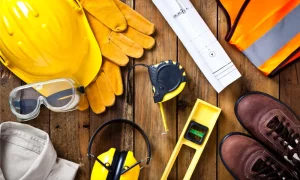In the construction sector, prioritizing ensuring safety in construction sites alongside financial planning is essential. Allocating funds for thorough training and high-quality safety equipment proves to be a smart investment, as it not only safeguards workers but also improves productivity and reduces costs associated with accidents over time. This approach raises an important question: how can companies effectively balance expenses with safety measures to exceed industry standards? Addressing this could redefine future strategies for construction site safety.
Key Takeaways
- Allocate the budget for high-quality safety equipment like helmets and harnesses to prevent injuries.
- Invest in advanced communication tools to ensure real-time safety updates and coordination.
- Fund comprehensive training programs to enhance safety skills and awareness among workers.
- Perform regular cost-benefit analysis to optimize investments in safety measures and reduce potential liabilities.
- Implement ongoing monitoring and updates of safety protocols to align with the latest industry standards and technologies.
Understanding Construction Site Risks
Why does understanding construction site risks matter? Recognizing hazards guarantees safety in construction sites, fostering a sense of security and community among workers. Strategically analyzing risks allows for preemptive measures, minimizing potential injuries and fostering a culture of vigilance and care. This proactive approach not only protects employees but also enhances operational efficiency, reinforcing a collective commitment to workplace safety.

Budgeting for Safety Equipment
Understanding construction site risks allows managers to identify the necessary safety equipment essential for maintaining worker safety. Strategic budgeting must prioritize:
- High-quality helmets and protective gear
- Advanced communication devices for real-time updates
- Reliable safety harnesses for height work
Allocating funds wisely guarantees every team member feels valued and protected, reinforcing a sense of belonging and commitment to safety on every project.
Training Programs as Investments
Investment in extensive training programs is a cornerstone of maintaining high safety standards on construction sites. By strategically developing skills and knowledge, companies foster a culture of safety and belonging among employees. Such training guarantees every team member understands their role in preventing accidents, promoting a proactive approach to safety that benefits the entire organization. Engaging in this practice is essential for continuous safety improvement.
Cost-Benefit Analysis of Safety
Building on the foundation set by training programs, a rigorous cost-benefit analysis of safety measures at construction sites reveals significant financial implications. Key findings include:
- Reduced Accident Rates: Lower insurance premiums and fewer compensation claims.
- Increased Productivity: Enhanced worker morale and efficiency.
- Long-term Savings: Significant reduction in legal liabilities and compliance penalties.
Investing in safety is not just ethical; it’s economically prudent.
Monitoring and Updating Protocols
While cost-benefit analysis underscores the financial advantages of initial safety investments, ongoing monitoring and updating of safety protocols are essential to maintaining these benefits over time. Regularly reviewing practices guarantees alignment with the latest industry standards and technological advancements. This strategic vigilance not only enhances worker safety but also fosters a sense of unity and commitment to collective well-being, reinforcing the value of guaranteeing safety in construction sites.
Frequently Asked Questions
What Insurance Policies Best Cover Construction Site Accidents?
To best cover construction site accidents, extensive general liability, workers’ compensation, and builder’s risk insurance policies are essential. They collectively address liability, employee injury, and property damage, safeguarding financial stability effectively.
How Do Weather Conditions Impact Safety Investment Needs?
Weather conditions profoundly influence safety investment needs on construction sites. Harsh weather necessitates enhanced protective measures and equipment to safeguard workers, thereby increasing financial allocations for safety training and resilient infrastructure to prevent accidents.
Are There Tax Benefits for Investing in Construction Safety?
Yes, tax benefits often exist for investing in construction safety, as businesses can typically deduct costs associated with safety training, equipment, and upgrades, aligning financial incentives with workplace health and safety priorities.
How Does Employee Turnover Affect Safety Training Costs?
High employee turnover increases safety training costs as continuous recruitment necessitates repeated training sessions. This not only strains financial resources but also impacts the cohesive safety culture essential for construction site security.
What Role Do Subcontractors Play in Ensuring Site Safety?
Subcontractors play an essential role in site safety, ensuring adherence to safety protocols and regulations. Their strategic integration into safety plans is vital for maintaining a secure environment and preventing accidents.
Conclusion
To sum up, prioritizing financial resources towards safety measures on construction sites proves economically prudent and ethically imperative. Investment in quality safety equipment and thorough training programs not only mitigates the risk of workplace accidents but also enhances productivity and reduces long-term operational costs. Continuous monitoring and updating of safety protocols are essential to adapt to emerging risks and technologies, ensuring sustained protection for workers and cost-efficiency for the organization.
Also Read: Non-Slip Coatings for Bathroom Safety


